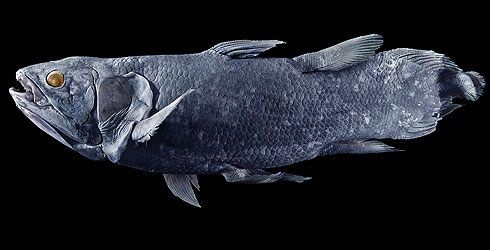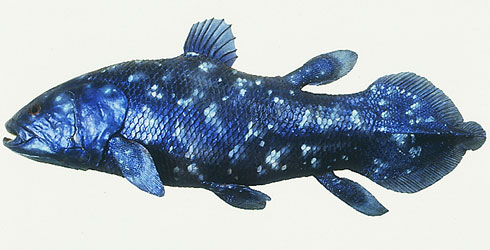Latimeria chalumnae
Coelacanths were only known from fossils until December 1938, when Marjorie Courtenay-Latimer, curator at the East London Museum in South Africa, found a very unusual fish in a fisherman's catch.
Unable to identify it, she tried to contact the ichthyologist J L B Smith (Rhodes University), but he was away on holiday. Because of the summer heat and lack of alcohol to preserve the fish, she was obliged to have it gutted, unfortunately losing valuable information on the internal anatomy.
Upon his return, Smith quickly identified the fish as a coelacanth, and its importance as the living representative of this long-extinct group. He named it Latimeria chalumnae, to honor Marjorie Courtenay-Latimer for her discovery, and after the Chalumna River, where it was caught.
As described in his book on the discovery, Old Four Legs, Smith spent the next 14 years searching for a second specimen of Latimeria, eventually finding a specimen off the Comoros Islands. Latimeria chalumnae has since been found in other sites along the east coast of Africa.
A second species of Latimeria, L. menadoensis, was found near Sulawesi, Indonesia in 1998. As with L. chalumnae, this new species was again originally spotted in a fisherman's market.
Species detail
-

Taxonomy
Find out about the evolution of coelacanths, and how Latimeria chalumnae relates to its extinct ancestors.
-

Biology and behaviour
Scientists have found evidence suggesting that extinct coelacanths bred by producing eggs, but Latimeria has been found to have pups. Read more about the biology of this unusual fish, and how it behaves.
-

Conservation and distribution
Latimeria chalumnae lives in deep, underwater caves, which it only leaves at night. Find out why this elusive fish is threatened with extinction.
Images

Specimen of the coelacanth Latimeria chalumnae. Coelacanths were thought to have died out 85 million years ago but have since been found off the south-eastern coast of Africa and in Sulawesi in 1998.

Specimen of the coelacanth Latimeria chalumnae. Coelacanths were thought to have died out 85 million years ago but have since been found off the south-eastern coast of Africa and in Sulawesi in 1998.

Latimeria chalumna
About the author
Dr Zerina Johanson
Curator, Vertebrates Curation Group, Department of Palaeontology.
A word from the author
"I would have loved to have been inspecting that fisherman’s catch with Marjorie Courtenay-Latimer in December, 1938!"
